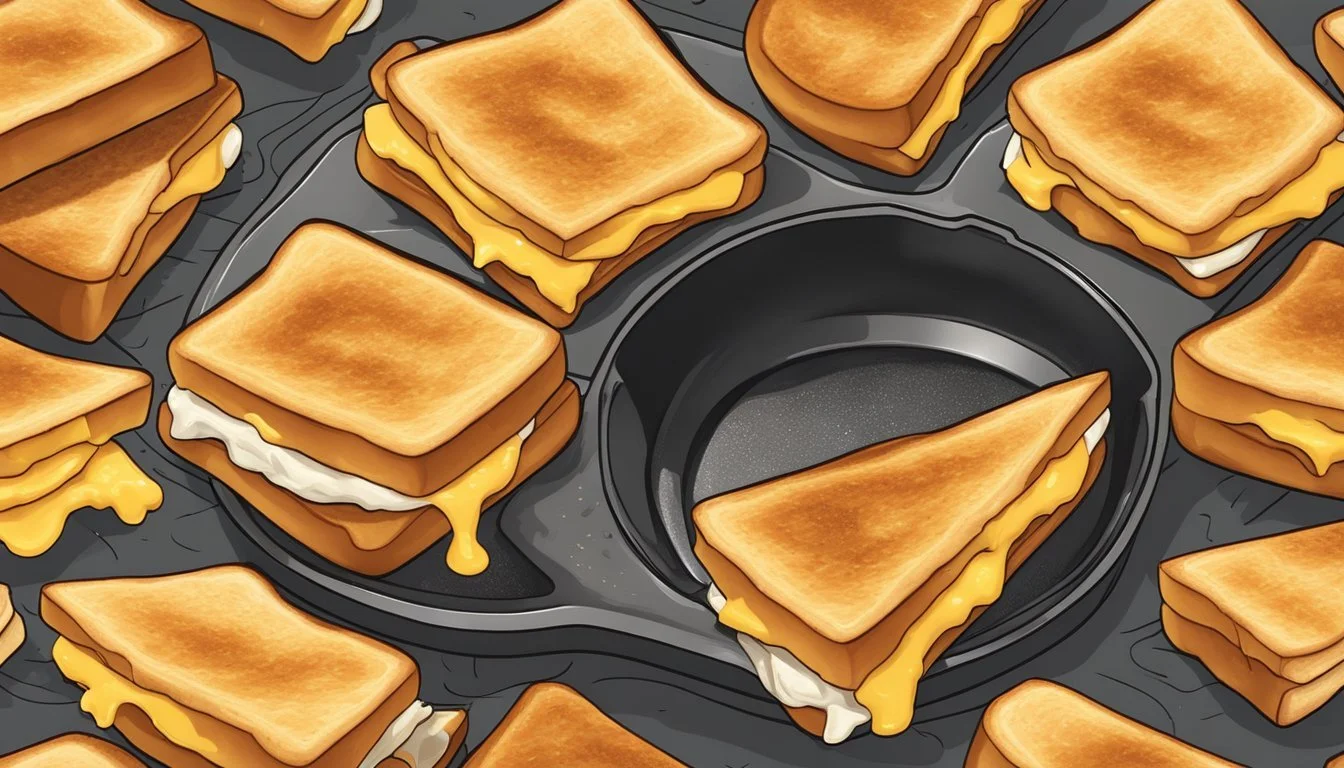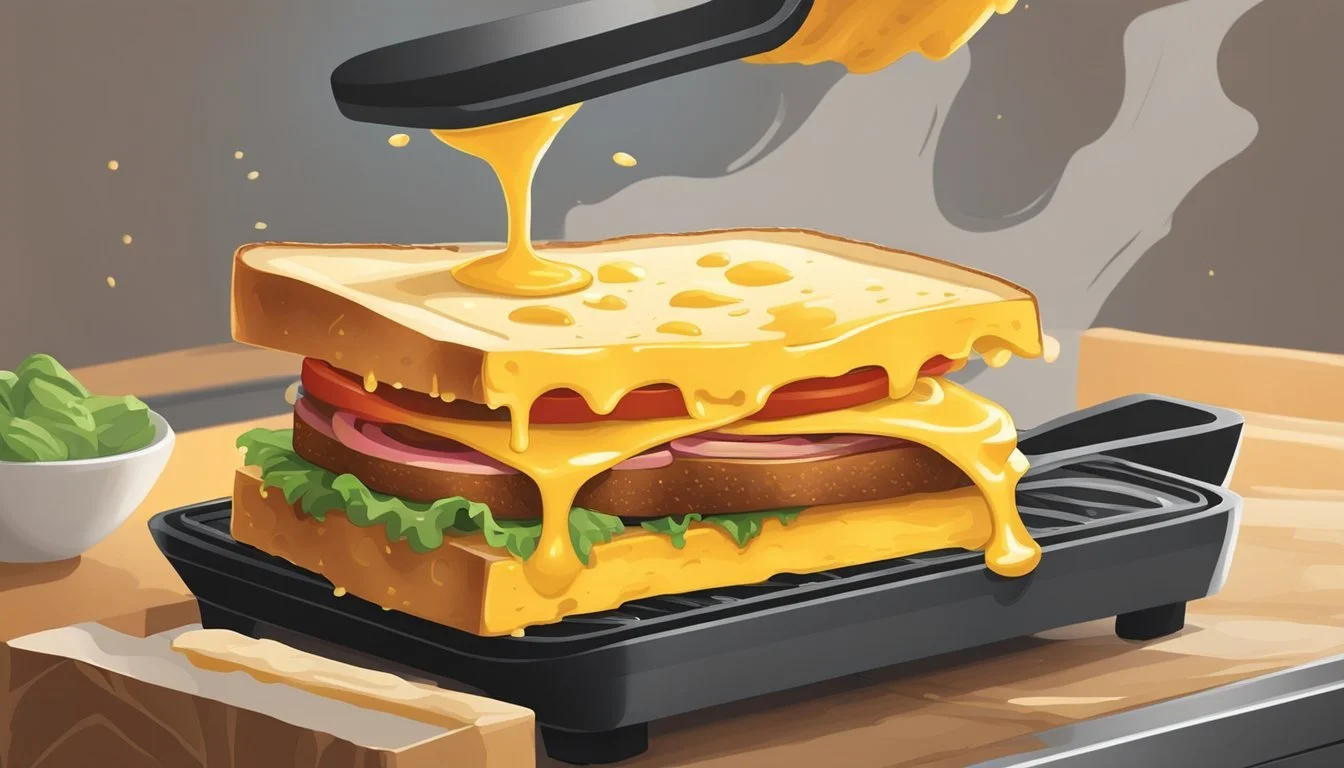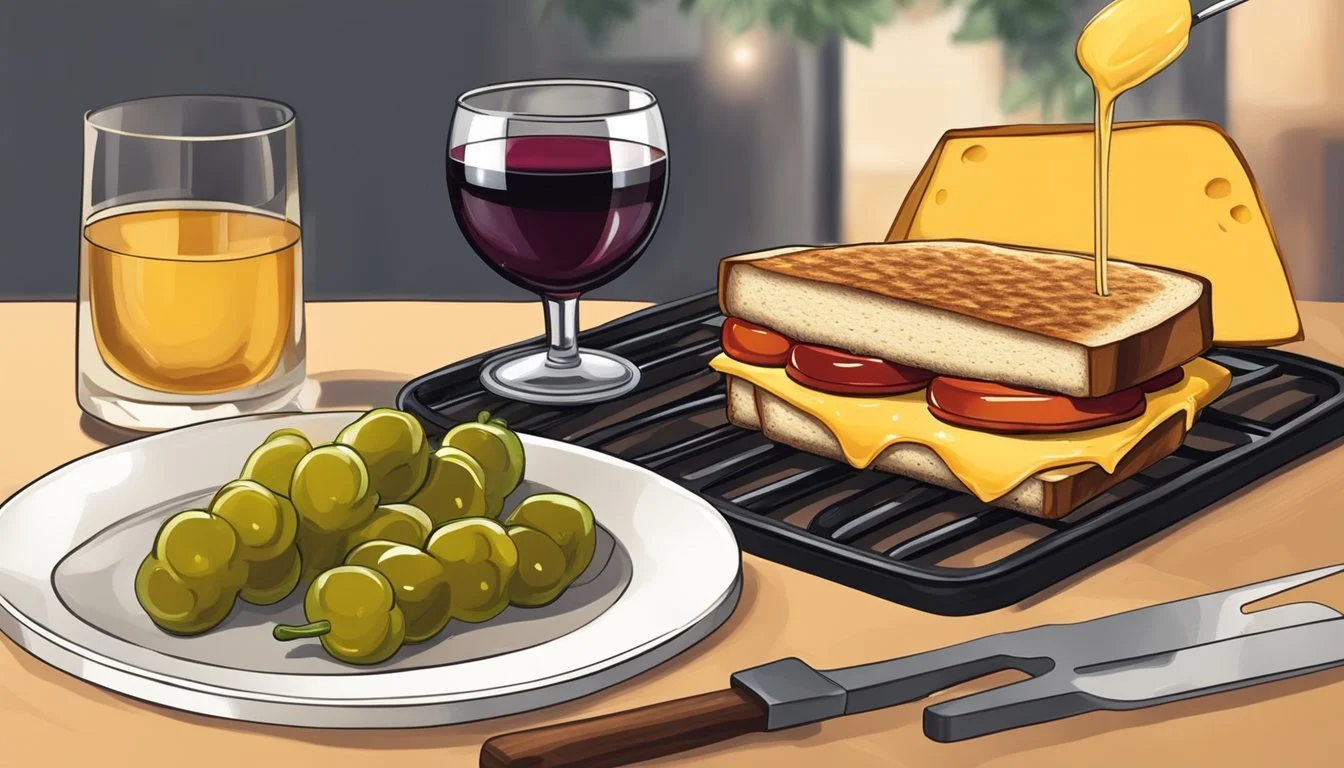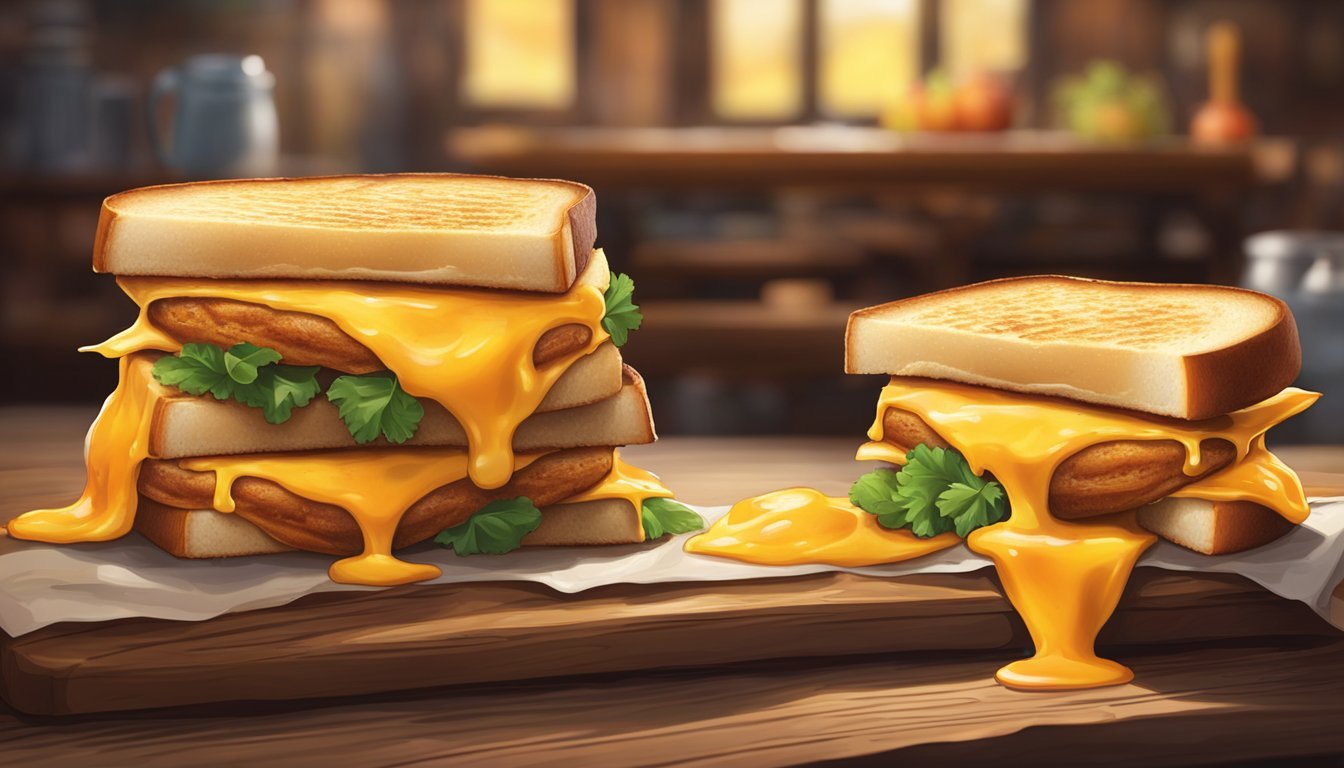The Iron-Grilled Cheese Sandwich
Mastering Crispy Edges Sans Toaster
The grilled cheese (What wine goes well with cheese?) sandwich enjoys a revered spot in the comfort food hall of fame. Its simplicity belies the mastery behind a perfectly crispy, golden exterior that gives way to a gooey, melted cheese center. Achieving this at home doesn't always require specialized equipment; in fact, many aficionados prefer the iron skillet method, swearing by its ability to impart those sought-after crispy edges and evenly melted cheese. The iron skillet's consistent heat distribution ensures each bite is infused with the nostalgic charm of a bygone era when cast iron was the cornerstone of kitchen cookware.
The technique for creating an iron-grilled cheese sandwich leans on time-honored principles: bread (What wine goes well with bread?) selection, buttering strategy, and proper heat management. Cooking the sandwich on medium heat allows for a gradual toast on the bread while affording the cheese inside ample opportunity to reach the optimal level of meltiness. Contrary to other methods that might call for a toaster or oven preheating, this recipe ensures that the entire sandwich, from the crust to the core, receives equal attention, creating a harmonious balance between crunch and melt.
The Essentials of Grilled Cheese
Grilled cheese sandwiches (What wine goes well with sandwiches?) are a staple that balance simplicity in preparation with richness in flavor. The selection of bread and cheese, along with the type of fat used for grilling, are pivotal to the sandwich's texture and taste.
Bread Selection
The foundation of any grilled cheese sandwich is the bread. It not only provides structure but also affects the overall flavor and crispiness of the sandwich. Sourdough bread is a popular choice for its tangy flavor and sturdy texture, which holds up well during grilling. It has approximately 130 calories and 27 grams of carbohydrates per serving, also offering protein, fiber, and a small amount of sugar and sodium.
Other options include:
Whole wheat: Nuttier flavor, more fiber
White bread: Traditional, softer texture
Cheese Choices
The heart of the sandwich is the cheese; it should melt well to create that iconic cheese pull. Cheddar cheese is a favorite for its sharpness and meltability, contributing calcium and protein to the sandwich. American cheese is known for its creamy melt and is lower in cholesterol compared to aged cheeses. Other melting cheeses to consider are:
Monterey Jack: Mild and slightly sweet
Swiss Cheese: Distinctive flavor, higher in sodium
Mozzarella: Delicate and creamy
For a gourmet twist, one can also explore Brie or Gruyère cheese.
Butter and Fats
The type of fat used in grilling is critical in achieving a crispy exterior without burning. Salted butter is traditionally used, infusing the sandwich with flavor and contributing to the golden-brown crust. It contains saturated fat and cholesterol but also imparts vitamin A.
Noteworthy alternatives include:
Unsalted butter: Allows for controlled seasoning
Olive oil: A healthier option with lower saturated fat
Each choice impacts the final calorie count and can alter the grilled cheese sandwich's taste profile and nutritional content.
Assembling the Perfect Sandwich
Crafting the ideal iron-grilled cheese sandwich involves precision in layering ingredients and ensuring a sublime meltdown of cheese. The nuanced application of heat transforms humble bread and cheese into crispy, golden perfection with a luscious melt.
Layering Ingredients
One begins with two slices of quality sliced bread; their sturdy texture crucial for withstanding the heat without becoming soggy. A common choice for many is a classic white or sourdough bread due to their neutral flavor and firm structure.
Butter: Spread a generous layer of softened butter on one side of each bread slice, ensuring edge-to-edge coverage. This layer promotes an even crisp on the outer surfaces as they cook.
Cheese: In the sandwich's heart lies the cheese – the soul of this dish. Use a mix of grated cheese for quick and even melting. A combination of cheeses like sharp chedar and American can impart both a rich flavor and the desirable cheese pull. Place a heaping amount between the unbuttered sides of the bread slices to prepare for the melt.
Crafting the Meltdown
The heat's role is not just to toast but also to achieve the perfect melted cheese quality that is both visually appealing and tantalizing to the palate.
Heat Skillet: Preheat a cast iron skillet over medium-low heat. This even heat source allows for a controlled environment, essential for achieving the quintessential golden brown without burning.
Cooking Sandwiches: Place the sandwich butter-side-down onto the hot skillet. The crisp texture emerges as the butter sizzles and browns the bread. After a few minutes, once the bottom has turned a delectable golden brown, flip the sandwich. Continue to cook until the cheese has melted thoroughly and the second side matches the first in its savory bronze hue.
Monitoring the heat is a balancing act; too high, and the bread burns before the cheese melts, too low, and the perfect grilled cheese remains an elusive dream with lukewarm, unmelted cheese. Thus, the sandwich maker's expertise lies in their ability to mediate this interplay between crisp and melt.
Mastering the Cooking Technique
To achieve a crisp, golden brown grilled cheese sandwich without a toaster, one must utilize the appropriate cookware and heat control. Mastery in these methods ensures a flavorful crust and melted cheese center.
Without a Toaster
A toaster might be the go-to appliance for making a crispy grilled cheese sandwich, but it's not the only way to achieve that perfect crunch. One can cook a grilled cheese using a variety of kitchen tools—each offering a unique texture and flavor to the bread.
Iron Skillet Method
Cooking with an Iron Skillet:
Preparation: Start by preheating your iron skillet on medium heat.
Butter or Mayonnaise: Apply a thin layer of butter or mayonnaise to one side of each bread slice to promote an even, golden brown texture.
Cheese Choice: Place your choice of cheese between the non-buttered sides.
Cooking: Transfer the sandwich to the skillet, buttered side down. Cover with a lid to ensure even melting.
Step Action Duration 1 Cook first side 3-4 minutes 2 Flip with spatula — 3 Cook second side 2-3 minutes
Alternative Cooking Approaches
Nonstick Skillet: Similar to an iron skillet, but offers easier cleanup. Use medium heat and follow the same steps.
Griddle: Provides a larger surface, ideal for multiple sandwiches. Heat it on medium, and use a spatula for flipping.
Waffle Iron or Panini Press: These appliances create a unique pattern on the bread while pressing the sandwich, achieving crispness throughout.
Sandwich Maker: A dedicated appliance that cooks both sides simultaneously, sealing the edges and ensuring even cooking.
Remember, when cooking grilled cheese, the "low and slow" approach is key to achieving that perfect, crisp exterior without burning the bread. It allows the heat to properly penetrate the sandwich, melting the cheese without overdoing the bread's surface. Whether using a skillet, griddle, or any alternative method, monitoring the heat and adjusting it as necessary are the core principles of mastering the cooking technique.
Achieving Crispy Edges Every Time
The secret to crispy edges on a grilled cheese sandwich lies in mastering the heat, understanding the role of fats, and perfecting the flip technique. These elements combine to create a toast with irresistibly crunchy edges and a buttery, golden-brown exterior.
Controlling the Heat
To ensure that the grilled cheese sandwich cooks evenly and acquires that desired crunchiness, one must be vigilant about the temperature of the cooking surface. A medium heat setting allows the bread to achieve a golden brown crust without burning. It's important to preheat the pan for a few minutes before adding the sandwich, then adjust the heat as needed to prevent the bread from browning too quickly.
The Role of Fats in Crunchiness
Fats, such as butter or mayonnaise, are essential for that delectable crunch. These fats should be spread evenly across the surface of the bread; a liberal but not excessive application works best. When the sandwich is placed in the pan, the fat creates a barrier that fries the bread, turning it into a crispy, golden brown delight.
Flip Technique
A confident flip ensures that both sides of the grilled cheese develop the same crispy, buttery texture. Wait until the first side has a crunchy exterior before flipping it to the other side using a spatula. This is typically after 3 to 4 minutes of cooking on the first side. The second side will often require less time since the pan retains heat from cooking the first side.
Serving and Pairing Ideas
When serving an iron-grilled cheese sandwich, the choices for side dishes and beverages can enhance the overall dining experience. Below are carefully selected complementing sides and drink accompaniments that elevate this classic comfort food.
Complementing with Side Dishes
An iron-grilled cheese sandwich pairs exceptionally well with a variety of side dishes. The key is to balance the richness of the sandwich with sides that can add a different texture or a refreshing contrast.
Classic Tomato Soup: A bowl of warm tomato soup offers a tangy and slightly sweet flavor profile that complements the creamy and crispy attributes of the grilled cheese.
French-Style Sides: Crispy French fries or golden potato wedges seasoned with herbs provide a satisfying crunch and are a traditional favorite.
Healthy Choices: Balance richness with a light green salad featuring a vinaigrette dressing or crisp baby carrots for some added nutrition without sacrificing flavor.
Beverage Accompaniments
Selecting the right beverage to go along with a grilled cheese can round out the meal, whether the goal is refreshment or complementing the flavor palette of the sandwich.
Wine Selection: A glass of Chardonnay or Sauvignon Blanc, with their bright acidity, can cut through the richness of the cheese.
Non-Alcoholic Options: For a non-alcoholic choice, a classic iced tea or a robust tomato juice can provide a pleasing contrast to the savory notes of the sandwich.
Customizing Your Grilled Cheese
Customizing a grilled cheese sandwich opens up a treasure trove of flavors and textures. Whether one prefers a classic taste or seeks to push the culinary boundaries, there are options to satisfy every palate.
Variations for the Adventurous Eater
For those who like to experiment, introducing different cheeses can dramatically alter the character of a grilled cheese sandwich. Cheddar provides a sharp taste, while Swiss and Fontina offer a milder, nutty flavor. Mozzarella is ideal for a stretchy, indulgent cheese pull. Adding proteins like bacon or ham can give the sandwich a salty, rich depth that complements the creamy cheese.
Cheese Options:
Cheddar: Sharp and distinct
Swiss: Mild and nutty
Fontina: Creamy with earthy notes
Mozzarella: Melty and stretchy
Protein Add-Ins:
Bacon: Crisp and savory
Ham: Salty with a hint of sweetness
Mixing cheeses can also provide a complex flavor profile. For instance, a combination of sharp cheddar and creamy mozzarella results in a sandwich that's both flavorful and gooey.
Dietary Adaptations
To accommodate different dietary needs, one can modify the standard grilled cheese recipe. For those reducing their meat intake, substituting bacon and ham with vegetarian options, such as grilled mushrooms or tomatoes, can maintain the sandwich's hearty feel. Individuals who prefer a lighter option might choose American cheese, which melts smoothly and offers a milder flavor.
Dietary Variations:
Adult Flavor Twist: A blend of aged cheeses for a gourmet touch
Vegetarian Options: Grilled mushrooms or tomatoes in place of bacon or ham
Lighter Fare: American cheese for a smoother, subtler flavor
Nutritional Considerations
When considering the nutritional impact of an iron-grilled cheese sandwich, it is essential to account for its caloric content and the balance of macronutrients and micronutrients it provides. Variations in cheese type, bread selection, and additional ingredients will influence these values.
Caloric Content
The caloric content of an iron-grilled cheese sandwich largely depends on the ingredients used. A typical grilled cheese made with American cheese and white bread contains approximately 378 calories per serving. Servings will vary in size, but a standard sandwich is cut into halves or quarters.
Macros and Micros
The nutritional balance of macronutrients in a grilled cheese sandwich includes carbohydrates, protein, and fats:
Carbohydrates: A source of energy, primarily from the bread, with an average of 33.4 grams.
Protein: Essential for body repair and growth, provided by the cheese, averaging around 15 grams.
Fat: Especially saturated fat, is found in cheese, with a typical sandwich containing 21.8 grams of total fat and 10.8 grams of saturated fat.
Micronutrients in a grilled cheese sandwich vary with ingredients but typically include:
Cholesterol: Around 51 milligrams.
Sodium: Given the cheese and bread, can be quite high, with an average sandwich containing about 923.4 milligrams.
Calcium: Provided by the cheese, contributes to bone health.
Vitamin A: Present in cheese, supports vision and immune function.
Dietary Fiber and Sugars are minimal unless whole grain bread is used, which increases these nutrients. Potassium content will also depend on the bread and cheese type.
Grilled Cheese for All Ages
Grilled cheese sandwiches offer a versatile and comforting treat that can be enjoyed by everyone, from young children to adults seeking a satisfying midnight snack. This beloved meal can easily be customized to suit different taste preferences and times of the day.
Kid-Friendly Versions
Young children often prefer simple and familiar flavors. Parents and caregivers can craft kid-friendly grilled cheese sandwiches with mild cheese options such as American or cheddar. For a nutritious twist, whole grain bread can be utilized to enhance the health benefits. Additionally, incorporating fun shapes using cookie cutters can make the meal both visually appealing and exciting for kids to eat.
Cheese Options for Kids:
American Cheese
Mild Cheddar
Bread Recommendations:
Whole Wheat Bread
Multi-Grain Bread
Fun Shapes:
Stars
Hearts
Adult Upgrades
For adults, a grilled cheese sandwich can transform into a gourmet experience or a savory midnight snack with some creative adjustments. Combining different types of cheeses, such as Gouda and Havarti, adds complexity and depth to the flavor. To add texture, one might introduce ingredients like caramelized onions or sundried tomatoes. Adults can also experiment with spreads like a layer of whole grain mustard or a hint of garlic mayo for an extra kick of flavor.
Cheese Combinations:
Gouda and Havarti
Pepper Jack and Swiss
Textures and Flavors:
Sundried Tomatoes
Spreads:
Whole Grain Mustard
Garlic Mayo
By adapting the basic grilled cheese formula, this sandwich can cater to the simplest of palates or to those seeking something more sophisticated for any time of the day.
Useful Tips and Tricks
To master the art of making an iron-grilled cheese sandwich, one needs to focus on proper technique and equipment. The following tips will help ensure that each sandwich has crispy edges and perfectly melted cheese.
Cookware and Utensils
Pans: A heavy cast iron skillet or griddle provides even heat distribution, essential for getting that evenly crispy crust. For those without iron cookware, a nonstick skillet is a suitable alternative.
Utensils: A sturdy spatula is necessary for flipping the sandwich without losing any melting cheese. For those looking to experiment, a waffle iron or panini press can add textured crispness to the sandwich.
Cheese Melting Tips
Cheese Choice: Choose a cheese that melts well, like cheddar for sharp flavor or Gruyère for a nutty taste. Shred cheese with a box grater to promote even melting.
Heat Control: Cook the sandwich over medium heat to allow the cheese to melt fully without burning the bread. A lid can be placed over the pan to trap heat and encourage melting.
Storage and Reheating
Storage: If there are leftovers, cool the sandwich completely before storing it in the refrigerator to prevent sogginess.
Reheating: To regain crispness, reheat the sandwich in a skillet over the stove rather than using a microwave, which can make the bread soggy.
By focusing on the right cookware and techniques, the iron-grilled cheese sandwich will elevate from a simple comfort food to a gourmet treat.
Conclusion
Achieving the coveted crispy edges on a grilled cheese sandwich without a toaster is entirely feasible. By using alternative methods, such as an iron or a skillet, one can ensure even crisping and a delectable texture. The iron-grilled cheese method aligns excellently with the classics of a grilled cheese recipe, delivering both a savory flavor and a satisfying crunch with each bite.
Steps to Consider:
Even Heating: An iron provides a uniform heat distribution.
Butter or Mayo: Apply a thin layer to the outer sides of the bread for a golden crust.
Cheese Selection: Choose meltable cheeses for a creamy interior.
Constant Watching: Vigilance prevents burning and ensures even cooking.
Essentials for Success:
Preheat the iron to achieve optimal temperature.
Press down lightly for an even crust.
Flip cautiously for uniform browning.
Utilize parchment paper if needed to keep the iron clean.
The iron-grilled cheese sandwich pays homage to the traditional grilled cheese recipe, yet it simplifies the process for those lacking typical kitchen appliances. Chefs can revel in the innovation of this technique, confident that the end product will satisfy both classic and creative palates alike.
Sharing and Social Engagement
In the age of digital connectivity, sharing culinary experiences like crafting the perfect iron-grilled cheese sandwich extends beyond the kitchen. Engaging with a community around food can transform cooking from a solitary task to a social interaction.
Join the Community
Social media platforms provide home cooks with a space to showcase their crispy-edged grilled cheese sandwiches made without a toaster. On Facebook, individuals often join groups dedicated to cast iron cooking, sharing photos of their culinary creations and seeking tips for perfecting their technique. Instagram has become a hub for food photography, where hashtags such as #GrilledCheese and #CastIronCooking connect users with a stream of mouthwatering visuals and recipes.
Pinterest offers a vast collection of grilled cheese recipes, with users creating boards dedicated to sandwich inspiration that others can discover and share. Food bloggers and enthusiasts often leverage Pinterest to drive engagement by illustrating the step-by-step process of making that ideal grilled cheese with a crispy exterior.
By participating in these online communities, one can exchange knowledge, gain inspiration, and even garner praise for a well-executed sandwich. Whether one prefers a classic cheese sandwich or innovative variations, these platforms unite individuals with a shared passion for this comfort food staple.












